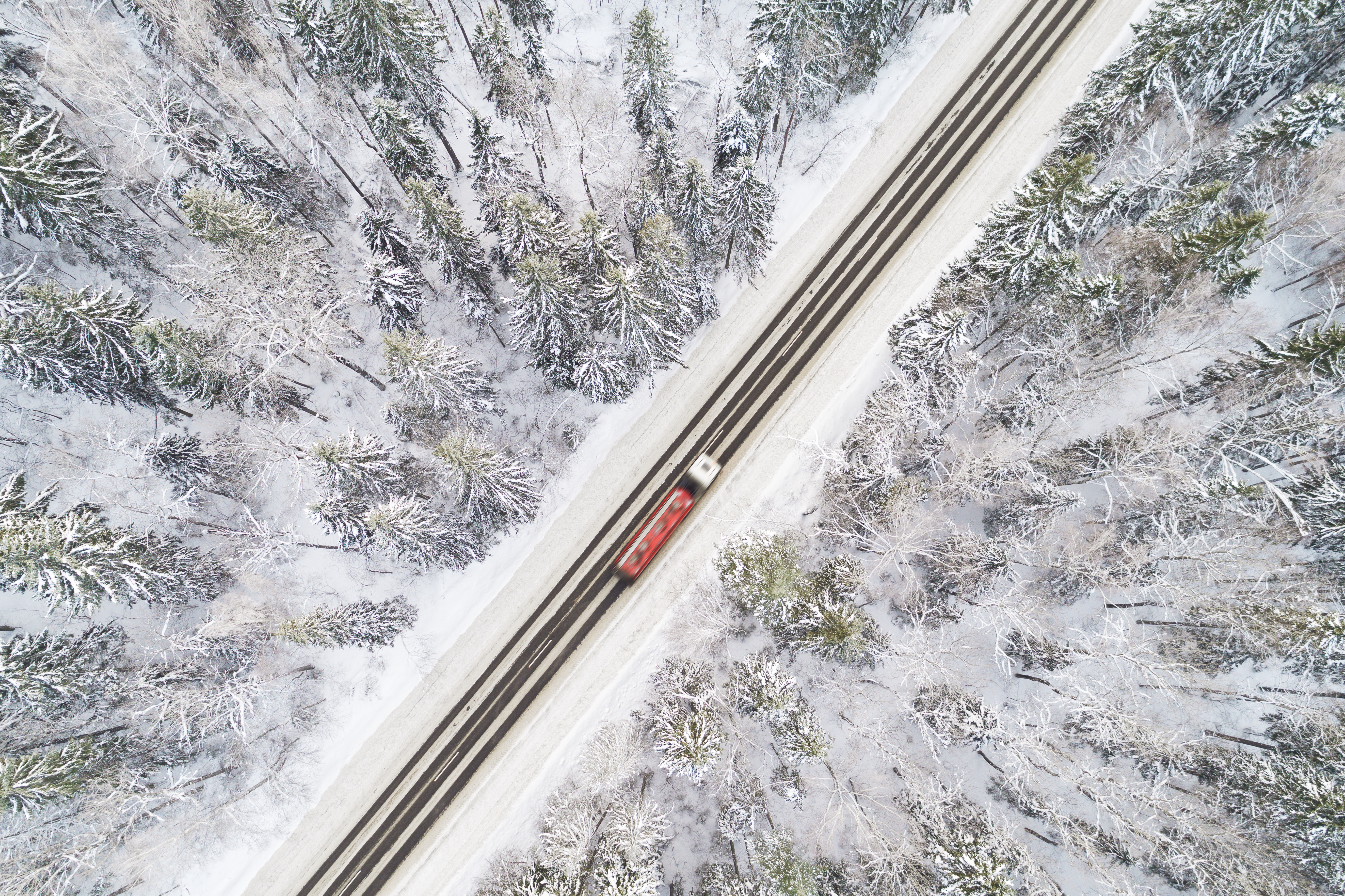
Miranda Blake
Przewodnik kierowcy ciężarówki po zimie w Europie
Utworzony: 16.10.2024
•
Aktualizacja: 28.08.2025
Kierowcy ciężarówek stają przed wyjątkowym zestawem wyzwań i obowiązków w chłodniejszych porach roku. Występuje wzrost liczby poważnych wypadków drogowych, przy czym [33% roszczeń ubezpieczeniowych zgłoszonych w tym czasie uznano za poważne] (https://atha.co.uk/news/why-you-are-more-likely-to-have-a-severe-road-traffic-accident-in-the-winter).
Przygotowanie jest więc kluczowe. Poniżej przedstawiamy wskazówki, jak kierowcy ciężarówek mogą zachować bezpieczeństwo zarówno na drodze, jak i w kabinie tej zimy.
Nawigacja w burzowych warunkach
Kluczowe jest, aby jechać powoli i utrzymywać bezpieczną odległość od innych pojazdów - szczególnie na zalanych obszarach. Należy wrzucić niski bieg i utrzymywać silnik na wysokich obrotach.
Poniższe wskazówki pomogą również podczas jazdy w burzową pogodę.
- W przypadku utraty kontroli nad pojazdem na wodzie należy zwolnić, zdejmując nogę z pedału gazu - nie należy gwałtownie hamować ani skręcać.
- Wyższe pojazdy są bardziej podatne na intensywne wiatry - upewnij się, że mocno trzymasz kierownicę i unikaj mostów, jeśli to możliwe.
- Jeśli ciężarówka jest pusta, podróżuj z otwartą plandeką. W ten sposób wiatr nie będzie miał na czym zaczepić.
Zarządzanie śniegiem i lodem
Jazda ze zmniejszoną prędkością i utrzymywanie wymaganej odległości od poprzedzającego pojazdu jest również czymś, co należy zrobić, gdy jest lód i śnieg. W rzeczywistości zaleca się zwiększenie drogi hamowania do 10-krotności normalnej wartości - jednak ocena tego może być trudna. Badanie Admiral wykazało, że czarny lód powoduje 10% wypadków w zimie. Możesz stwierdzić, czy jedziesz po czarnym lodzie, jeśli droga wygląda na mokrą, ale nie ma rozprysku pochodzącego z innych pojazdów.
Inne wskazówki pomagające w jeździe po śniegu obejmują regularne przeglądy ciężarówki i upewnienie się, że przed podróżą masz cały niezbędny sprzęt, taki jak kable rozruchowe i narzędzia do odladzania. Ponadto zawsze pamiętaj o tym, na jakim biegu powinieneś jechać, ponieważ może to uchronić Cię przed utratą kontroli nad pojazdem. Na płaskich nawierzchniach jedź na najwyższym możliwym biegu. Zjeżdżając ze wzniesienia, używaj hamulca silnikowego i jedź na niskich biegach. Aby uniknąć buksowania kół, podczas ruszania używaj wyższego biegu - zapewni to przyczepność niezbędną do ruszenia pojazdem.

Zapewnienie widoczności
Ze względu na niebezpieczne autostrady i czynniki zewnętrzne negatywnie wpływające na widoczność i powodujące wypadki ciężarówek, widoczność ma kluczowe znaczenie w każdych warunkach pogodowych, zwłaszcza gdy jest chłodniej. Dlatego należy sprawdzić, czy na przedniej szybie nie ma odprysków lub pęknięć, ponieważ mogą się one szybciej rozprzestrzeniać w chłodniejszych miesiącach.
Ponadto należy zapewnić najwyższy poziom widoczności świateł, tablicy rejestracyjnej i przedniej szyby. Oprócz usuwania śniegu i brudu, warto regularnie myć pojazd, aby uniknąć gromadzenia się soli drogowej (powoduje to korozję).
Jeśli widoczność jest słaba, a warunki stają się zdradliwe, najlepiej zjechać z drogi i odpocząć na najbliższym postoju dla ciężarówek. Jeśli konieczne będzie przekroczenie limitu [godzin jazdy] (https://snapacc.com/newsroom/discover-the-new-drivers-hours-rules/), można skorzystać ze specjalnego zwolnienia dla kierowców, którzy utknęli w wyjątkowych okolicznościach, takich jak ekstremalne zjawiska pogodowe.
Ocena głębokości bieżnika opony
Niskie temperatury mogą również wpływać na funkcjonalność opon, ponieważ mogą powodować obniżenie ciśnienia powietrza. Zużyte opony niestety wydłużają drogę hamowania i zmniejszają poziom stabilności na mokrych i oblodzonych drogach, a niski bieżnik powoduje poślizg.
W związku z tym dobrym pomysłem jest sprawdzanie głębokości bieżnika przed każdą podróżą w burzowych i innych trudnych warunkach - w ten sposób będziesz wiedzieć, kiedy musisz poradzić sobie z pojawiającymi się problemami.
Przestrzeganie przepisów dotyczących opon zimowych
Ważne jest również, aby znać różne przepisy dotyczące opon zimowych. Niektóre kraje zobowiązują kierowców do posiadania worków z piaskiem i łopat, podczas gdy łańcuchy śniegowe są obowiązkowe w innych. Continental opracował prosty [przewodnik po wymaganiach dotyczących opon zimowych] (https://www.continental-tyres.co.uk/b2c/tyre-knowledge/winter-tyre-laws/) dla Wielkiej Brytanii i Europy.
Od 1 listopada opony zimowe są obowiązkowe:
- Austria
- Czechy
- Finlandia
- Francja
- Litwa
- Serbia
W innych krajach są one obowiązkowe pod koniec miesiąca lub w grudniu lub zależą od warunków pogodowych. Jeśli chodzi o opony z kolcami, to choć są one dozwolone w poniższych krajach, obowiązują w nich surowe zasady. Najlepiej sprawdzić przepisy dla każdego kraju przed podróżą.
- Austria
- Białoruś
- Dania
- Estonia
- Finlandia
- Francja
- Wielka Brytania
- Łotwa
- Liechtenstein
- Litwa
- Norwegia
- Hiszpania
- Szwecja
- Szwajcaria
- Turcja
- Ukraina
Przyniesienie odpowiednich materiałów
Musisz także pomyśleć o tym, jak zadbać o siebie zimą. Zabrzmi to jak oczywistość, ale upewnij się, że masz dostęp do wystarczającej ilości jedzenia i picia. Ze względu na zwiększone ryzyko zamknięcia dróg w chłodniejszych porach roku, nie zawsze będziesz w stanie dostać się na postój dla ciężarówek. Przygotuj się na przekąskę lub posiłek, a najlepiej gorący napój w termosie.
Zwłaszcza jeśli nie masz dostępu do miejsca do odpoczynku, upewnij się, że możesz się ogrzać. Na przykład zabierz ze sobą akumulatorowe zestawy grzewcze. Podobnie, zawsze miej pod ręką ciepłą i zapasową odzież; będzie to szczególnie pomocne, jeśli odzież zmarznie i zmoknie podczas wykonywania zadań, takich jak usuwanie śniegu z przedniej szyby.
Idealnie byłoby mieć zimowy zestaw przetrwania - składający się z jedzenia, napojów, przenośnej ładowarki do telefonu, latarki, koców, kamizelki odblaskowej, łopaty i wytrzymałych butów do chodzenia.
Gwarancja dostępu do przystanków z intruzem
Chociaż nie masz wpływu na pogodę, możesz chronić siebie i innych na drodze. Obejmuje to upewnienie się, że masz bezpieczne miejsce do zaparkowania tak szybko, jak to możliwe. Nasza aplikacja intruck lub [strona z mapami] (https://snapacc.com/map/) poinformuje Cię o pobliskich dostawcach usług wraz z informacjami o oferowanych przez nich udogodnieniach.
Aplikację intruck można pobrać już dziś, klikając [ten link] (https://intruckapp.com/download/).



